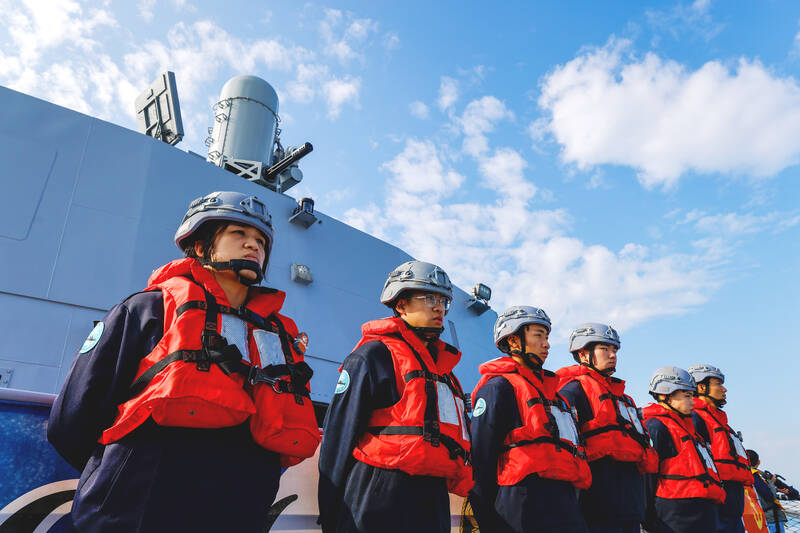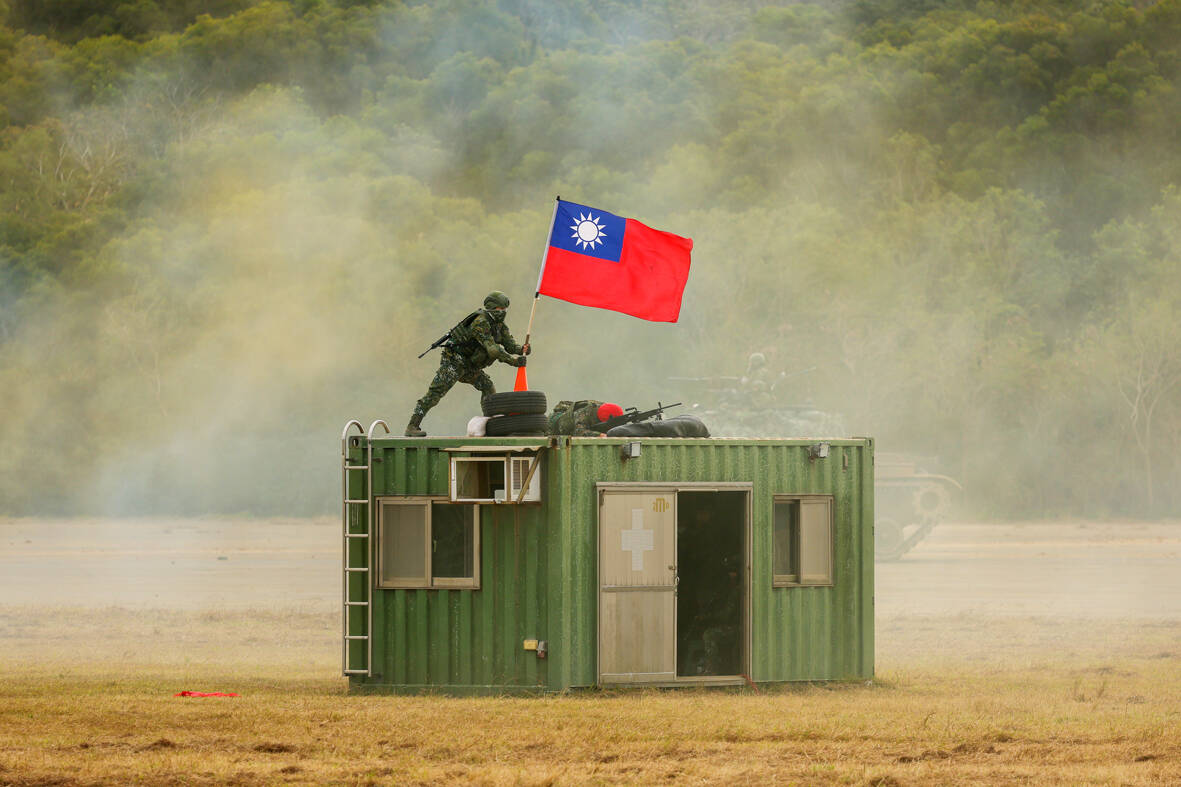China’s military launched a record number of warplane incursions around Taiwan last year as it builds its ability to launch full-scale invasion, something a former chief of Taiwan’s armed forces said Beijing could be capable of within a decade.
Analysts said China’s relentless harassment had taken a toll on Taiwan’s resources, but had failed to convince them to capitulate, largely because the threat of invasion was still an empty one, for now.
Xi Jinping’s (習近平) determination to annex Taiwan under what the president terms “reunification” is no secret. He has publicly and stridently promised to bring it under Communist party (CCP) control, subsumed into the Chinese motherland, by force if necessary, on multiple occasions including as recently as his New Year address to the nation.

Photo: EPA-EFE
HARASSMENT
But in an effort to force Taiwan’s hand without resorting to a direct military attack, the military — the People’s Liberation Army (PLA) — has targeted it with waves of harassment and intimidation, using anything from weather balloons to aircraft carriers.

Photo: EPA-EFE
This has all combined with continued non-military tactics, including legal and cyber warfare, disinformation campaigns, and the weaponization of diplomatic and trade relationships.
But until China is capable of a full-scale invasion, such tactics are “meaningless” as long as Taiwan does not surrender, said retired admiral Lee Hsi-min (李喜明), a former head of the armed forces.
“The overarching strategy is to make you capitulate,” Lee said.
The PLA’s Taiwan-focused tactics could be broadly categorized into four types, he said. “Intimidatory” tactics included gray zone warfare such as its near-daily incursions into Taiwan’s air defense identification zone (ADIZ), “coercive” tactics could be a blockade or quarantine, “punitive” attacks included missile bombardments and “conquest” was a full-scale invasion.
The coercive tactics include what Admiral Tang Hua (唐華), commander of Taiwan’s navy, told the Economist in October was an “anaconda strategy” by the PLA to squeeze Taiwan, trying to exhaust its response system, force mistakes and perhaps trigger an excuse to launch a blockade.
In several incidents — including as recently as early this month — undersea communications cables to Taiwan have been cut or damaged, allegedly by Chinese ships. Severing communications is one key element experts expect would be part of a blockade or attack.
Lee said the intimidatory approach was designed to deter Taiwan from declaring independence, and had so far been successful. The aim of any coercive and punitive measures would be to force Taiwan’s government or people to capitulate on unification. Lee said the PLA was fully capable of those three types of measure but had yet to launch a blockade or attack because it wasn’t yet able to enact the fourth: conquest.
“If they don’t have capability to conduct full-scale invasion, then taking any one of the first three won’t work,” Lee said. “If Taiwan does not capitulate when they conduct this anaconda approach then what could China do?”
US intelligence reportedly believes Xi has given the PLA a 2027 deadline to reach capability of a full-scale invasion. Lee said no one can predict exactly when they’ll be ready because it was a dynamic assessment also involving Taiwan’s own defensive capabilities, and ongoing corruption issues in the PLA, but he believed it would be within a decade.
INTO THE GRAY ZONE
In the meantime, training — often in the form of gray-zone warfare — has continued.
Most of it has taken the form of air force flights into Taiwan’s air defense identification zone (ADIZ). Warplanes are flying more often, in larger numbers, and increasingly close to Taiwan. Every incident forces Taiwan’s military to respond, wearing down its resources and morale, and eroding warning times as Taiwan is forced to shrink the territorial space it can practically cover.
In 2022, 1,727 Chinese military planes flew into Taiwan’s de facto ADIZ, double the previous year’s total. In 2023 it was a similar number, heavily concentrated during military drills launched in April and September in purported retaliation to what it called Taiwan’s “separatist activities” including a meeting between then president Tsai Ing-wen (蔡英文) and senior US officials.
Last year, there were more than 3,000.
Ben Lewis, a defense analyst who maintains an open-source tally of ADIZ incursions, says the increase last year is particularly stark given that there were actually very few in the first part of the year.
Lewis’s data, based on Taiwan defense ministry reports, shows a lull in ADIZ incursions in the months leading up to Taiwan’s presidential election in January, which many analysts at the time said was likely a decision by Beijing not to risk playing into the China threat narrative which the ruling Democratic Progressive party and its presidential candidate, William Lai (賴清德), had campaigned on.
Beijing will usually link its drills and grayzone activities to perceived provocations, including Taiwan engaging in acts of sovereignty or international diplomacy, or the US — which has numerous military bases stationed in the region — conducting activities like freedom of navigation exercises.
After Lai was inaugurated in May, Lewis said there was an “unprecedented surge” in PLA air force and navy incursions, rising steadily until it peaked in July with more than 430 incursions, nearing the record high reported in August 2022 during the PLA drills after Nancy Pelosi visited. There were also spikes during the military drills.
Due to changes in the Taiwan defense ministry’s reporting methods early last year, it is no longer possible to see what type of PLA planes flew, or where. The reduced transparency is a “missed opportunity” by Taiwan to get international attention, said Lewis.
“There’s a spectrum and diversity of the PLA’s course of activity against Taiwan — balloons, UAVs [such as drones], maritime law enforcement, ADIZ activity, whatever the joint patrols are — that can get people’s attention and help us learn about what the PLA is doing. But they’re just not sharing enough.”
SOPHISTICATED OPERATIONS
Besides the ADIZ incursions, the PLA has also demonstrated more sophisticated joint operations, drone encirclements of the island, missile tests and integration of civilian forces. In its annual report on China’s military developments, the US defense department said the PLA had “long emphasized the importance of joint firepower strikes as a component of large-scale operations” and have been explicitly tied to a Taiwan invasion in PLA writings.
Military drills held in May and October — named Joint Sword 2024 A and B — surrounded Taiwan’s main island with joint exercises by all branches of the PLA and, for the first time, the increasingly militarized Coast Guard. The exercises “really demonstrated the PLA’s ability to surge forces, get people up and moving and to seize the operating area,” Lewis said. “It doesn’t mean they can hold it but it means they can take it at good pace.”
Taiwan’s officials have now come to expect multiple PLA drills ostensibly targeting Taiwan each year, but Lewis said Taiwan has managed to “maintain strong control” with their responses each time.
“It takes a lot of professionalism and capability to respond to a major militia exercise surrounding all sides of your island when the goal of the exercise is to demonstrate how much more capacity China has than Taiwan,” he said.
The analysts expect the PLA tactics to continue and escalate this year. The DPP-led government in Taipei resoundingly rejects the prospect of Chinese rule, as does a majority of Taiwan’s people. They appear unlikely to capitulate. But Lee said for now, Beijing has at least achieved its goal of deterring Taiwan from advancing its sovereignty or independence.
“And in the meantime they can practice or prepare or establish their capability for the final goal,” he said.

Most heroes are remembered for the battles they fought. Taiwan’s Black Bat Squadron is remembered for flying into Chinese airspace 838 times between 1953 and 1967, and for the 148 men whose sacrifice bought the intelligence that kept Taiwan secure. Two-thirds of the squadron died carrying out missions most people wouldn’t learn about for another 40 years. The squadron lost 15 aircraft and 148 crew members over those 14 years, making it the deadliest unit in Taiwan’s military history by casualty rate. They flew at night, often at low altitudes, straight into some of the most heavily defended airspace in Asia.

Beijing’s ironic, abusive tantrums aimed at Japan since Japanese Prime Minister Sanae Takaichi publicly stated that a Taiwan contingency would be an existential crisis for Japan, have revealed for all the world to see that the People’s Republic of China (PRC) lusts after Okinawa. We all owe Takaichi a debt of thanks for getting the PRC to make that public. The PRC and its netizens, taking their cue from the Chinese Communist Party (CCP), are presenting Okinawa by mirroring the claims about Taiwan. Official PRC propaganda organs began to wax lyrical about Okinawa’s “unsettled status” beginning last month. A Global

Taiwan’s democracy is at risk. Be very alarmed. This is not a drill. The current constitutional crisis progressed slowly, then suddenly. Political tensions, partisan hostility and emotions are all running high right when cool heads and calm negotiation are most needed. Oxford defines brinkmanship as: “The art or practice of pursuing a dangerous policy to the limits of safety before stopping, especially in politics.” It says the term comes from a quote from a 1956 Cold War interview with then-American Secretary of State John Foster Dulles, when he said: ‘The ability to get to the verge without getting into the war is

Like much in the world today, theater has experienced major disruptions over the six years since COVID-19. The pandemic, the war in Ukraine and social media have created a new normal of geopolitical and information uncertainty, and the performing arts are not immune to these effects. “Ten years ago people wanted to come to the theater to engage with important issues, but now the Internet allows them to engage with those issues powerfully and immediately,” said Faith Tan, programming director of the Esplanade in Singapore, speaking last week in Japan. “One reaction to unpredictability has been a renewed emphasis on